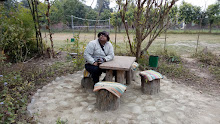Heliotropium indicum L.
HATHISHURA - NATIVE TO ASIA !!
COMMON NAME : Indian heliotrope.
BOTANICAL NAME : Heliotropium indicum L.
FAMILY : Boraginaceae (forget me not family)
HABITAT AND HABIT : common weed grows in disturbed areas close to water sources. On sunny, periodically moist, or marshy and desiccating sites; waste places, ditch borders, dried-up pools and ditches, on spread mud, along roads, common weed in waste places and settled areas often very common. Flowering season extended, the first-formed seeds already dropping while there are still unopened buds. Rainfed, upland and rice fields.
DESCRIPTION : commonly known as Indian heliotrope, is an annual, hirsute plant that is a common weed.
ROOT : Woody base with long Taproot-- white or brown.
STEM : It has a hairy stem, erect, grooved, hollow, bearing alternating ovate to oblong-ovate leaves. may be branched or unbranched.
LEAVES : Leaves simple, not lobed or divided, alternate, spiral, or sometimes basal ones opposite, stalked, ovate, more than 2 cm long/wide, hairy, scabrous, margin entire, apex acute, base obtuse or rounded, pinnately veined. Distinctly petiolate, petioles to 5 cm long. Its margin slightly wavy-crisped.
INFLORESCENCE : The inflorescence uncoils after the central flowers, which are the oldest, mature. The flowers are arranged on only one side of the inflorescence.
FLOWER : Flowers are pale violet (lilac) with a yellow throat, but fading to dull white, calyx-lobes linear-lanceolate, ciliate, 2 mm long; corolla-tube 4-5 mm long; petals rounded.
FRUIT : Fruit nut-like, is 3.5 mm long, ovoid, ribbed, separating into 2 nutlets each 2-celled, 3-3.5 mm long. and immature fruit, the two lobes of the fruit are visible.
USES :
>>Medicinal use:
In fusion of the leaves and young shoots are used to treat nettle rash. Infusion of the flowers taken in small doses regulates menstruation, where large doses are abortive. Decoction of the leaves are used as a vermifuge. Juice of the leaves is antiseptic and anti-inflammation and applied to wounds, sores, boils, gum-boils and pimples on the face. Boiled with castor oil, it is applied to scorption bites. It is also employed locally in nophthalmia, when the cornea is inflamed or excoriated.
ECONOMIC IMPORTANCE :
>>In the Philippines, the plant is chiefly used as an herbal medicine. The extracted juice from the pounded leaves of the plants is used to cure wounds, skin ulcers and furuncles. The juice is also used as an eye drop for conjunctivitis. The pounded leaves are used as poultice.
SOURCES :
>>http://en.wikipedia.org/
>>http://www.oswaldasia.org/
>>http://
>>http://www.globinmed.com/
+hathasumre.JPG)
%5D+ban+tulsi.JPG)










0 comments:
Post a Comment